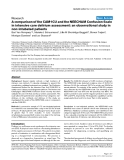
Confusion and delirium
Xem 1-1 trên 1 kết quả Confusion and delirium
-
Tuyển tập các báo cáo nghiên cứu về y học được đăng trên tạp chí y học Critical Care giúp cho các bạn có thêm kiến thức về ngành y học đề tài: A comparison of the CAM-ICU and the NEECHAM Confusion Scale in intensive care delirium assessment: an observational study in non-intubated patients...
 7p
7p  coxanh_4
coxanh_4
 26-10-2011
26-10-2011
 62
62
 3
3
 Download
Download
CHỦ ĐỀ BẠN MUỐN TÌM
TOP DOWNLOAD













